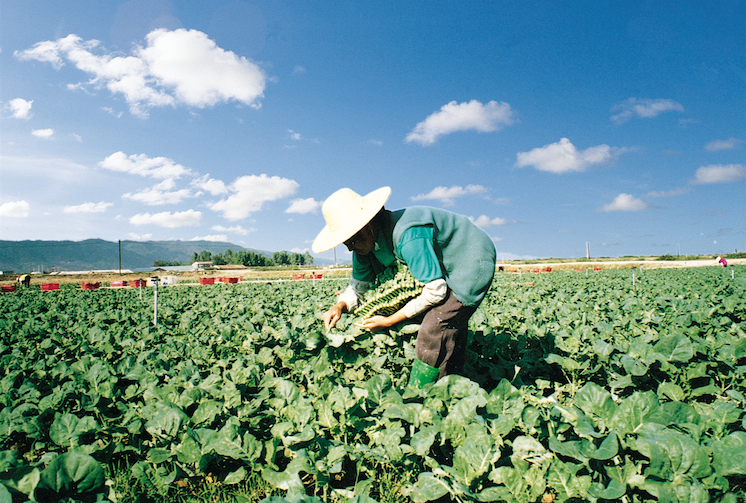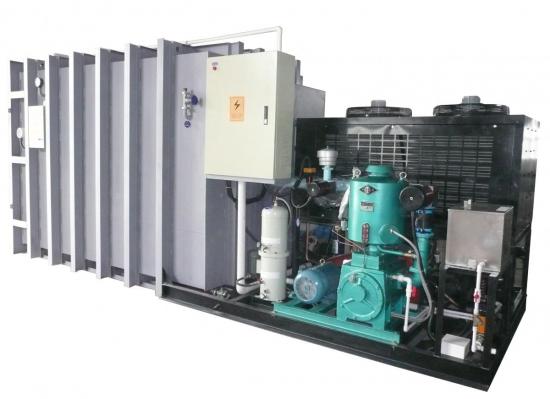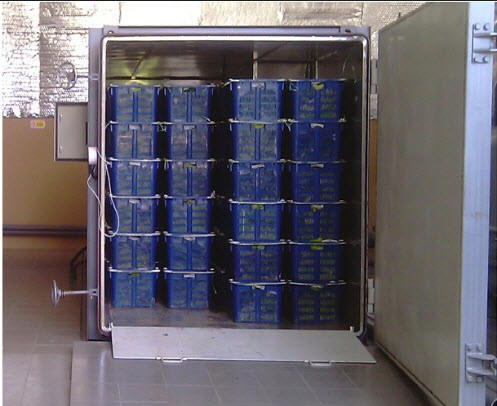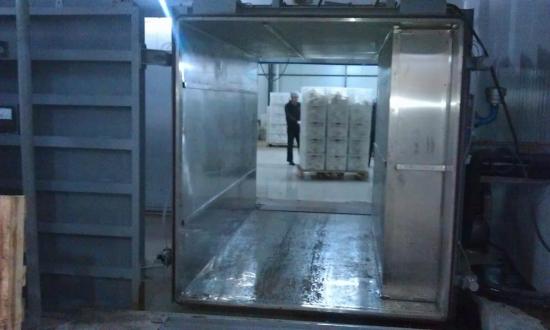Based on International Trade Administration (ITA) information, global losses in the food industry accumulate to more than $750 billion on a yearly basis. The losses are primarily due to inadequate facilities, improper food safety measures, and insufficient training of personnel working within the cold chain—a temperature-controlled supply chain developed to extend and ensure product shelf life.
Every year, poor cold chain systems result in the loss of billions of tons of fresh food—particularly in developing markets. While there are widespread efforts on improving agricultural processes to increase food production, nearly half of all food produced never actually makes it to a consumer’s table. (1)
Bringing Benefits to Traditional Cold Chain Systems
During the summer season, vegetables tend to deteriorate quickly once harvested from the field—or during postharvest stage of the cold chain. In traditional cold chain systems, vegetables are put into a chilled cooler for preservation, a process that requires approximately 12 hours for the product to achieve proper temperature. In some instances, as much as 25 percent of food product in the chilled cooler will decay before arriving at a proper storage area. Fortunately, there is a process for improving the effectiveness of the postharvest stage—vacuum cooling.

Vegetables can deteriorate quickly during the postharvest stage of a cold chain system.
Vacuum cooling can be applied shortly after harvesting crops, helping to rapidly cool the product and preserve shelf life. The theory of the process is to reduce product temperature from ambient temperature, say 90°F (32°C) during the harvest season, to around 39°F (4°C)—within 30 minutes. The process can be applied to vegetables, fruits, flowers and other food products. It is an excellent way to preserve and extend freshness, and can also ensure product uniformity. By using vacuum cooling, in conjunction with other vital pieces of the cold chain, product freshness can be better sustained.
There are many beneficial features of vacuum cooling process, including:
- There is no time limit for harvesting crops.
- The product is always ready for delivery to supermarkets or dockyards after coming out from a vacuum cooling chamber.
- Product freshness and cleanliness are ensured.
- There is a higher yield per harvest with the reduction in withered and spoiled product.
- It is possible to harvest in poor weather conditions, such as rain.
- Products can be cooled inside cartons.
ULVAC Technologies, Inc., a leading supplier of production systems, instrumentation and vacuum pumps, has introduced vacuum cooling equipment and systems to the agricultural, food and floral markets. The company provides vacuum cooling systems for use in large-scale farms to extend product shelf life. The systems are mainly used for fresh agricultural products, including vegetables, fruits and mushrooms. The company’s vacuum cooling equipment can also be used for flowers, meats and prepared foods, such as airplane meals. Over ten systems have already been installed in the United States.

Vacuum cooling systems can bring tremendous benefits to traditional cold chain systems.
Cold Chain Requirements
As mentioned previously, a cold chain is a temperature-controlled supply chain designed to maintain the quality of sensitive products. Cold chains comprise storage and distribution systems, and every step of the chain must be maintained in order to deliver a quality product. Cold chain system requirements will vary based on differences in the size, type and amount of products being stored and transported. Agricultural products, like fruits and vegetables, require cool facilities and storage at about 55°F. Dairy products and meat products are typically stored just below freezing, at 35°F and 28°F, respectively. Finally, frozen products, such as ice cream, could require deep freezing, and the required temperatures vary between -10°F to -150°F.
In regards to vegetables and other agricultural products, the postharvest step is the first step in a cold chain system, and it must maintain the same level of quality as every other step in the process, such as cold storage in a warehouse or shipping vessel. According to the ITA, “A single breakdown in the chain can result in catastrophic losses of product.” (1) By addressing the postharvest step of the cold chain with vacuum cooling technology, product losses can be dramatically reduced, and product quality can be ensured at the onset of a product’s journey.
How Does Vacuum Cooling Work?
The vacuum cooling process begins when a large vacuum chamber is filled with agricultural product, such as fresh vegetables. Under vacuum, free water in the cell tissues of the vegetables begins to evaporate at a pressure of around 12 Torr. The vegetables then cool themselves, due to the removal of the latent heat of the evaporated water. Since it takes 597 calories to evaporate 1 gram of water at 32°F (0°C), the vegetables are cooled to 39°F (4°C) in about 20 to 30 minutes. The vacuum chamber is then maintained at a low vacuum level.

Within 20 to 30 minutes, vacuum cooling systems cool products to 39°F (4°C).
As only 2 to 3 percent of the water is vaporized, there is no danger for drying out the vegetable, or reducing the product’s weight. The large amount of water vapor generated inside the vacuum chamber is condensed on the surface of a cooling coil, called a cold trap, and removed from the chamber later. The system uses a refrigerator to maintain the cooling coil at a temperature below 32°F (0°C).
Vacuum cooling machines comprise a vacuum chamber, a cold trap with a refrigerated unit, vacuum pumps and a control panel. ULVAC offers four models that can cool two to six pallets of agricultural products per batch. The machine uses reliable vacuum pumps manufactured by ULVAC Japan. It also incorporates refrigeration units manufactured by Copeland. ULVAC vacuum cooling equipment features fully automatic control, and end users can simply press the “start” button to engage the process, which is completed in less than 30 minutes. With LAN connection, ULVAC can diagnose the machine performance anywhere in the world.

Vacuum cooling systems from ULVAC can cool two to six pallets of agricultural products per batch.
Implementing Vacuum Cooling Systems Globally
Since the development of Japan’s first large-scale experimental system for vegetable vacuum cooling (under the Cold Chain promotion policy of the Japan Science and Technology Agency) in 1967, ULVAC has delivered many vacuum cooling systems to leading agricultural cooperatives in Japan. These systems are highly acclaimed for their outstanding efficiency and reliability. In 1997, ULVAC transferred the technology to Hong Kong ULVAC to continue the manufacturing and promotion of vacuum cooling technology inside China. From 1998 to 2015, Hong Kong ULVAC has sold over 500 vacuum cooling systems in China, other southeastern Asian countries, and in North American countries.
When Hong Kong ULVAC started this project in 1998, farmers in Southern China Provinces were exporting their vegetables in chilled containers to Asian countries, such as Singapore, Malaysia and Thailand. Due to poor attention to detail at the postharvest stage of the cold chain, about 25 percent of the vegetables decayed before arriving at a client’s site. When ULVAC introduced vacuum cooling technology to those farmers, they applied it to their export vegetables, resulting in a reduction in waste from 25 percent to 3 percent.
Since then, Hong Kong ULVAC has also introduced this technology to farmers in Northern China provinces. These farmers can also reduce the wastage rate when exporting vegetables to Japan and Europe.
About ULVAC Technologies, Inc.
![]()
ULVAC Technologies, Inc. is a leading supplier of production systems, instrumentation, vacuum pumps and components for the semiconductor, MEMS, solar, flat panel display, research automotive, medical, electrical, and refrigeration industries. ULVAC Technologies uses a class-10 process development laboratory and customer demonstration facility to meet the unique needs of different markets. ULVAC Technologies is a subsidiary of ULVAC, Inc., which is made up of over 50 companies engaged in most sectors of the vacuum industry.
ULVAC's corporate philosophy aims to contribute to the evolution of industries and sciences by using vacuum technologies and other peripheral technologies. Since 1952, ULVAC has provided "ULVAC Solutions," diversely incorporating equipment, materials, analysis, and services for flat panel displays, electronic components, semiconductors, and other general-industry equipment.
For more information, contact Ryoshin Imai, email: rimai@us.ulvac.com, or visit www.ulvac.com.
To read more about Vacuum for the Food Industry, please visit www.blowervacuumbestpractices.com/industries/food.
References
1. Miller, J., & Harsh, B. (2015). 2015 Top Markets Report: Cold Chain (United States, International Trade Administration, Industry & Analysis). ITA.
http://trade.gov/topmarkets/pdf/Cold_Chain_Top_Markets_Report.pdf



